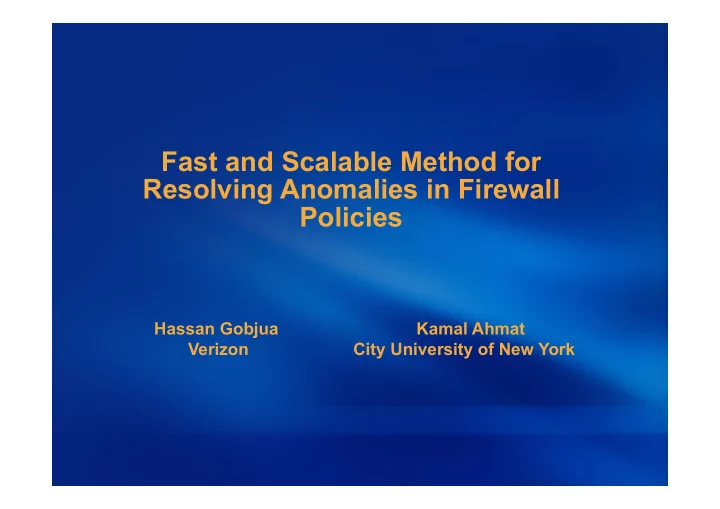

Fast and Scalable Method for Resolving Anomalies in Firewall Policies Hassan Gobjua Kamal Ahmat Verizon City University of New York
Introduction � Firewalls � Types of Anomalies � Related Work � Data Structure and Algorithm � Experimental Results � Conclusion
Firewalls � Firewall � System acting as an interface of a network to one or more external networks. � Implements the security policy of the network � By deciding which packets to let through � Based on rules defined by the network administrator.
Example
Protection Methods � Firewalls – Firewall policy rules should be designed carefully! � Challenges � Rules are created by multiple people � Rules are created over extended period of time � Number of rules in a firewall policy can be 5K+! � Rules are dynamic!
Relationships Between Rules - Disjoint Rules � T wo rules r and s are disjoint if they have at least one criterion for which they have completely disjoint values Example: <IN, TCP, 64.233.179.104, 80, 192.168.20.* , ANY, ACCEPT> <IN, TCP, 64.233.179.104, 80, 172.16.20.* , ANY, REJECT>
Relationships Between Rules - Exactly Matching Two rules r and s are exactly matched if each criterion of the rules match exactly. Example: <IN, TCP, 64.233.179.104, 80, 192.168.20.*, ANY, ACCEPT> <IN, TCP, 64.233.179.104, 80, 192.168.20.*, ANY, ACCEPT>
Relationships Between Rules - Inclusively Matching (Shadowing) � T wo rules r is a subset, or inclusively matched of another rule s if there exists at least one criterion for which r ’s value is a subset of s ’s value and for the rest of the attributes r ’s value is equal to s ’s values. Example: <IN, TCP, 64.233.179.104, 80 , 192.168.20.3 , ANY, ACCEPT> <IN, TCP, 64.233.179.104, ANY , 192.168.20.* , ANY, ACCEPT>
Relationships Between Rules - Correlated � Two rules r and s are correlated if r and s are not disjoint, but neither is the subset of the other. Example: <IN, TCP, 64.233.179.104, ANY , 192.168.20.3 , ANY, ACCEPT> <IN, TCP, 64.233.179.104, 80 , 192.168.20.* , ANY, REJECT>
Existing Work � E. W. Fulp – O(n^3) algorithm to order rules in a given policy; it doesn't discover correlated ones. � E. Al-Saher et al . – Method for selecting rules based on their probability. � A. Liu – Method to discover and remove redundant rules (Exact matching).
Our Approach � We aim at removing few troublesome rules from given policy to resolve anomalies. � Design a data structure to represent dependencies among rules. � Remove troublesome rules. � Return a subset of consistent rules and correlated rules (for editing).
Our Approach � Design a data structure to represent dependencies among rules. � Graph D is directed, and U is undirected. � Each node in U represents a rule � Two nodes are connected in U if there is shadowing or correlation relationship between these two rules. � Graph D describes dependency among rules.
Our Approach � Select a rule that doesn’t depend on any other rule (terminal node) from D. � Remove corresponding links from U and links/nodes from D. � If graph U is disconnected and new component formed, continue, else there is correlation � If there is correlation, choose the rule with highest probability.
Example
Example – Our Approach
Complexity � O(n^2) to construct graphs D and U � O(2log n ) to discover dependencies � Algorithm complexity O( n ^2 log n )
Experimental Results � Two sets of test experiments executed: � Real-life tests: five policies of size 107, 361, 647, 881, and 1385 over a month period on Verizon firewall using the original (non-improved) approach. � Tests done over the same period using improved approach. � Five test sets have been executed on synthetic policies of sizes 10K – 30K.
Experimental Results – Real-Life Policies
Experimental Results – Synthetic Policies
Current & Future Work � Find exact minimum number of rules to eliminate all anomalies from policy. � Modify algorithm to handle dynamic- policies. � Improve the algorithm performance.
Thank You All! Questions?
Recommend
More recommend